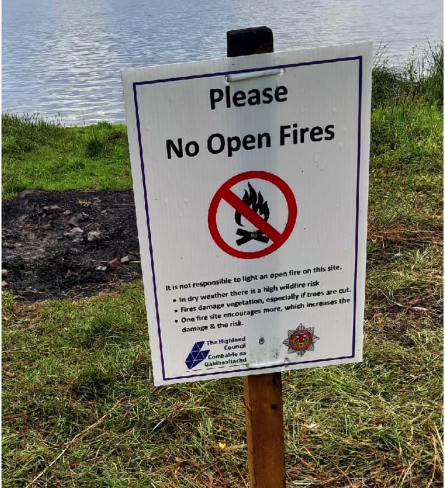
Following my post on Fires, hypocrisy and access rights I was alerted that Highland Council, rather than fulfilling their statutory duty to uphold access rights, had themselves been putting up “No Fires” signs.
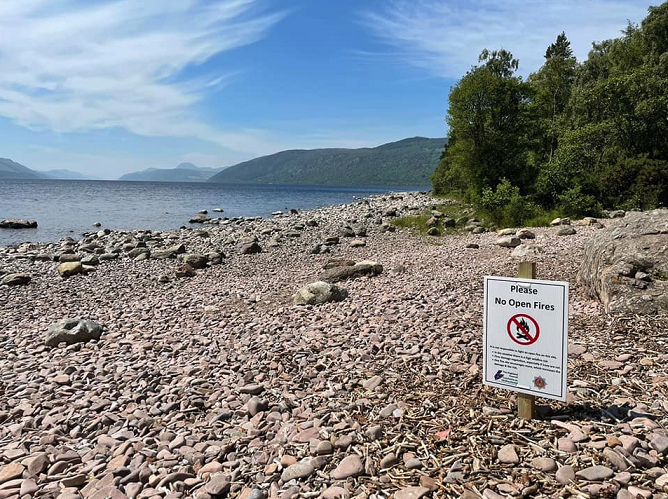
These signs are contrary to the Scottish Outdoor Access Code (SOAC) which was approved by the Scottish Parliament:
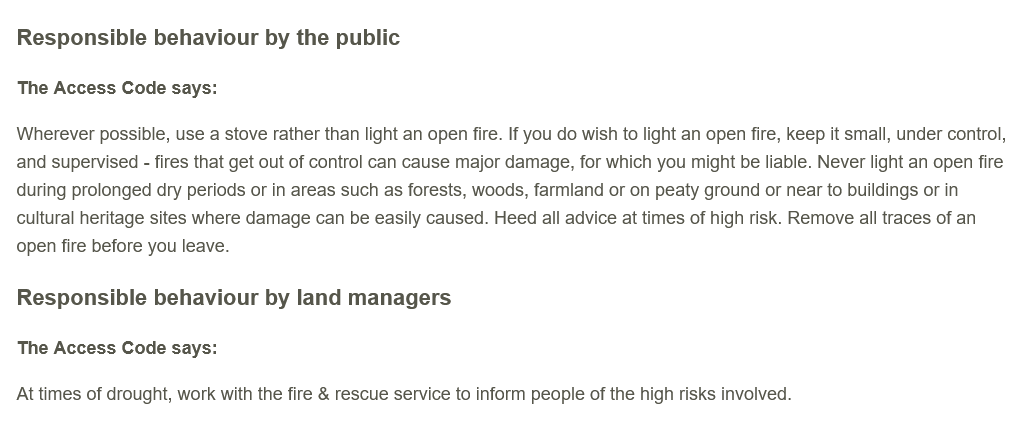
The meaning of “Wherever possible, use a stove rather than light an open fire” isn’t the same as “No open fires” . The following sentences in the SOAC make that clear by providing further guidance about lighting open fires.
The SOAC does, however, allow for site specific signs and Highland Council would appear to be using that to justify its use of this sign when it claims “It is not responsible to light an open fire on this site” [my emphasis]. That overall message might be quite reasonable if the sites were in the middle of a peat bog but they are not and the three bullet points used to justify the message are all contrary to the SOAC and have very dangerous implications:
1) “In dry weather there is a high wildfire risk”. Comment: “Dry weather” has a very different meaning to “during prolonged dry periods”. It’s dry ground conditions, which are the consequence of sustained period/s of dry weather, which are important, not the weather per se. If Highland Council wanted to promote SOAC and be helpful it could have stated “Please no open fires during prolonged dry periods when there is a high fire risk” but it didn’t.
2) “Fires damage vegetation, especially if trees are cut”. Comment: fires can damage vegetation but to claim they always do as in this statement is clearly not true as Highland Council’s own photo (above) perfectly illustrate. Fires on pebble beaches next to large bodies of water pose very little fire risk (even during prolonged dry periods), while the damage caused by lighting fires on grass needs to be seen in perspective: it is tiny compared to the impact of muirburn. Chopping trees for firewood, a criminal offence and stupid because live wood doesn’t burn well, is a separate issue and the fact it happens occasionally is not justification for trying to remove a statutory right.
3)“One fire encourages more, which increases the damage and the fire risk”. According to this logic, when one person sees another exercising their access rights, that will encourage more to do the same activity. That would be wonderful if true, we would have thousands more people walking and many of the health problems that plague Scotland would no longer exist. But the fact that the reasoning bears little resemblance to reality – it could equally well be argued that seeing people enjoying a fire responsibly would increase the number of “responsible fires” – is less important than the implications. Apply the same argument to litter: if one person walking up Ben Nevis drops litter (which poses risks to wildlife), that will encourage more so why not then put up signs saying “It is not responsible to walk up Ben Nevis as one piece of litter encourages more”?
While no public authority would dare at present go that far with walking, they are using similar arguments to try and stop camping: one tent attracts more, the more tents the more risk of bare batches developing on grass (“damage”), hence let’s erect some “please no camping” signs. The whole purpose of access rights was to remove any ambiguity about whether people had a right to undertake certain recreational activities, including the lighting of fires on land. These signs show that Highland Council, an access authority which has a statutory duty to uphold those rights, is instead actively working to undermine them.
Highland Council’s justification for the signs
The person who alerted me to the signs, tried last year to point this out to the Access Officer for Sutherland and Caithness, and has given me permission to publish the response they received from him in full:
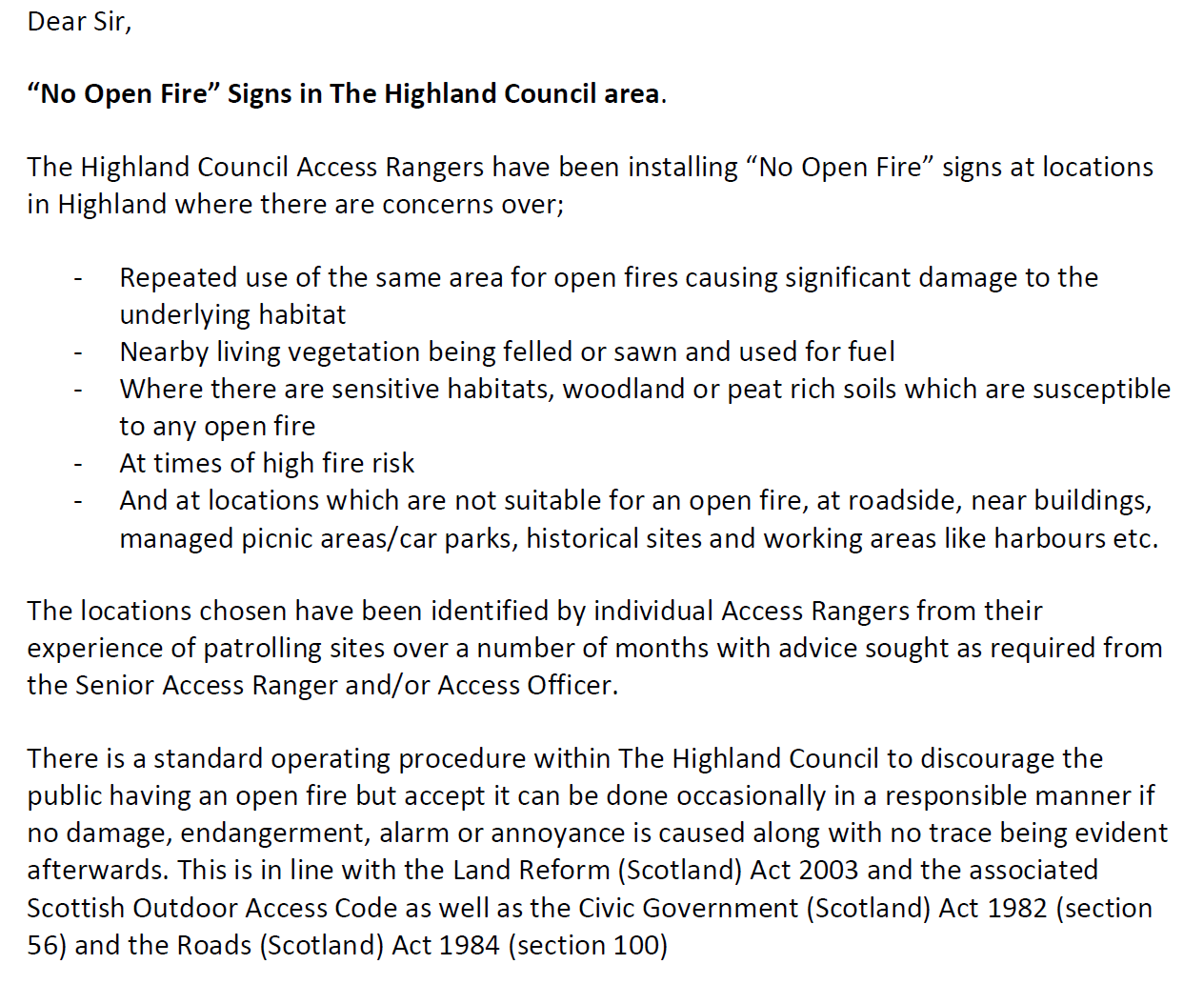 Comment. While the decision to erect one of these signs on a pebbly beach apparently lay with the individual ranger the next paragraph reveals there is now a standard operating procedure to “discourage the public from having an open fire”. In other words Highland Council staff are now driven by procedures to put up signs designed to discourage people from exercising their access rights even if the Council does recognise that those access rights “can be done occasionally in a responsible manner”.
Comment. While the decision to erect one of these signs on a pebbly beach apparently lay with the individual ranger the next paragraph reveals there is now a standard operating procedure to “discourage the public from having an open fire”. In other words Highland Council staff are now driven by procedures to put up signs designed to discourage people from exercising their access rights even if the Council does recognise that those access rights “can be done occasionally in a responsible manner”.

Not only Highland Council, however, a host of other public authorities have got together and decided to adopt a similar procedure to discourage people from exercising their access rights. This explains why a “no open fires” policy appeared in the Cairngorms National Park Authority Partnership Plan, which I commented on in December as being contrary to SOAC (see here). This is of course totally wrong. It is not up to officials to take it into their own hands to change the law.
It’s particularly concerning that this move not only involves access authorities but NatureScot, which is supposed to be the “keeper” of the SOAC. If staff in the public bodies responsible for upholding access rights don’t think the law is fit for purpose, they should be seeking resolutions from their Boards/Committees to ask the Scottish Government to change the law through due legal process instead of subverting the law behind the scenes. Elected councillors and Board Members of NatureScot should be appalled or are they part of the problem?
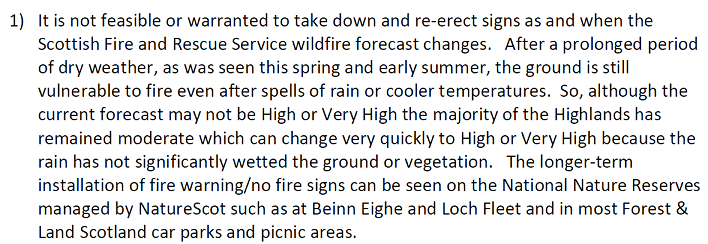
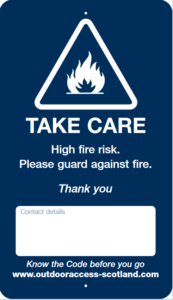 Having argued at the start of the letter that part of the justification for the signs was to alleviate concerns at time of “high fire risk”, the author goes on to claim that its not “feasible or warranted” for warning signs to be erected at those times. This is another poor argument. Under the SOAC template signs were developed which were designed only to be erected when needed or allow information to be added showing WHEN the advice they contain was “in force”, e.g. for deer stalking, woodland management, lambing (see here for templates). Indeed, the template sign for fire risk (left) was clearly designed for temporary use when risks were high, although I have seen it left in place year round in woodland areas.
Having argued at the start of the letter that part of the justification for the signs was to alleviate concerns at time of “high fire risk”, the author goes on to claim that its not “feasible or warranted” for warning signs to be erected at those times. This is another poor argument. Under the SOAC template signs were developed which were designed only to be erected when needed or allow information to be added showing WHEN the advice they contain was “in force”, e.g. for deer stalking, woodland management, lambing (see here for templates). Indeed, the template sign for fire risk (left) was clearly designed for temporary use when risks were high, although I have seen it left in place year round in woodland areas.
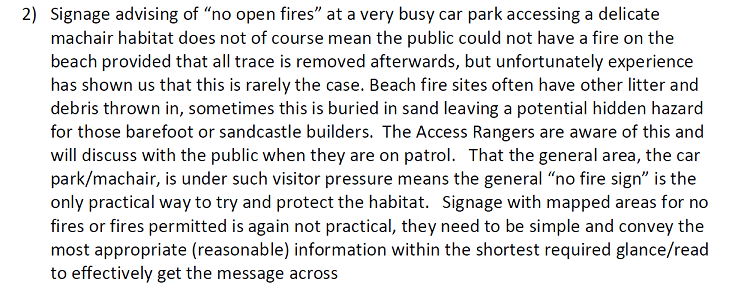
Finally, the Access Officer tries to address the obvious weakness in their position – that recreational fires in places like beaches pose little risk of causing wildfires – by bringing in other risks such as chopped trees or broken glass to justify their stance. Accept that and you accept that people shouldn’t be able to walk up Ben Nevis because they might walk off the path, putting pressure on “habitats” or drop litter.
 The sign are not in line with existing legislation and attempt to ban a perfectly legal activity. This paragraph confirms that there has been a conspiracy by staff within public authorities to try and stop the public from enjoying fires – they have not always taken this position – and to undermine the law. This is indefensible. Not only that but the statement that it is in fact quite possible to light a fire responsibly under access rights shows their position is totally incoherent too.
The sign are not in line with existing legislation and attempt to ban a perfectly legal activity. This paragraph confirms that there has been a conspiracy by staff within public authorities to try and stop the public from enjoying fires – they have not always taken this position – and to undermine the law. This is indefensible. Not only that but the statement that it is in fact quite possible to light a fire responsibly under access rights shows their position is totally incoherent too.
Highland Council’s Ranger Service and access rights
Last year, in response to increased visitor pressures and the anticipated rise in staycations, Highland Council significantly increased the size of its Ranger Service over the summer. The challenge facing the newly expanded Ranger service was considerable: grossly inadequate visitor facilities and infrastructure; large numbers of visitors many of whom had limited experience of being in the countryside in Scotland; and significant pressure from local residents to address specific issues that were causing them anything from mild inconvenience to grief. The expanded Ranger Service did a whole load of good things (see here) but also, following the example set by the Loch Lomond and Trossachs National Park Authority, started to post photos of “irresponsible behaviour” primarily of campers.
Whether that was wise is a legitimate question as it provoked the usual howls of outrage. But there was also some informed criticism about how the Rangers where applying the law which forced them to respond:
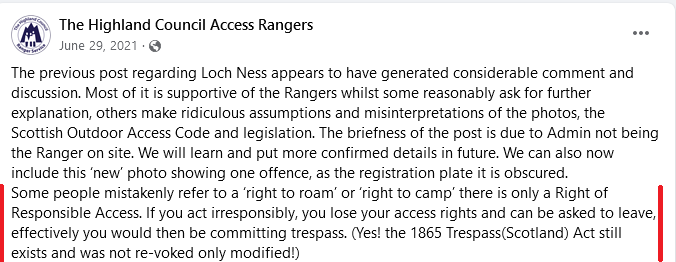
After castigating people who had dared to comment on the Rangers’ understanding of the SOAC in this particular incident (which had involved Rangers asking campers to move on), the post want on to demonstrate a lamentable mis-understanding of the law. Let me explain.
Our Public Authorities have for some time now been claiming there is a “only a Right of Responsible Access”. That is to mis-represent the law. Clause 1 of the Land Reform (Scotland) Act creates a statutory right to cross land or be on it for certain specified purposes including outdoor recreation (i.e both roaming and camping!) with no reference to responsibilities. The next two clauses then introduce responsibilities, Clause 2 for people exercising exercising rights and clause 3 for those managing the land. Both are required to act responsibly and in the case of people managing the land, like Highland Council Ranger Service, that doesn’t give them the right to make the law up as they go along.
But that is what this Ranger has done when they try to depict anyone who is not acting “responsibly” as being a “trespasser”, a very loaded term (see here) Legally, this is not the case. Prior to the Land Reform (Scotland) Act, thousands of people, whether rural residents taking a walk in the fields by their houses or hillwalkers from the cities, enjoyed the countryside without ever being treated as trespassers. In legal terms we were there by “implied consent”, although whether any landowner could have reversed that consent for the general public, rather than specific people named in an interdict, is a moot question. The point here, however, is that if someone behaves in such a way as to lose their access rights, their legal position reverts to what it was before the Land Reform (Scotland) Act was passed: “trespass” would then need to be established.
The introduction of the reference to the Trespass (Scotland) Act 1865 shows even less understanding of the law. That Act was very limited in scope, contrary to what the Ranger implies, criminalising lodging in premises (squatting), encampments, occupying land and the lighting of fires without permission or consent (that word again):

Neither squatting nor encampments are activities that fall under access rights so the potential application of the 1865 Act to people exercising access rights irresponsibly is limited to cases involving fires and possibly camping, if “occupying” land could be shown to include sleeping in a tent for a night. There is no case law that I am aware of prior to the Land Reform Act which shows the 1865 Act was ever applied to recreational campers: so that leaves fires, the focus of this post.
SNH produced guidance on access rights and the law on fires in 2007(see here):
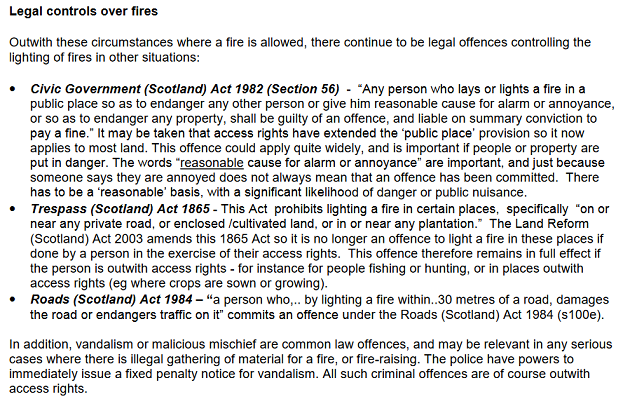 This shows that the application of the 1865 Trespass Act to fires is limited to areas near roads, enclosed land or plantations. SNH’s interpretation of the Trespass Scotland Act as amended appears to be that it only applies if the person is engaged in activities that fall outwith access rights (i.e those listed under Section 9 of the Land Reform Act such as hunting). It seems quite likely therefore that the Trespass (Scotland) Act 1865 couldn’t be applied to someone lighting a fire under access rights even if they do so in an irresponsible manner.
This shows that the application of the 1865 Trespass Act to fires is limited to areas near roads, enclosed land or plantations. SNH’s interpretation of the Trespass Scotland Act as amended appears to be that it only applies if the person is engaged in activities that fall outwith access rights (i.e those listed under Section 9 of the Land Reform Act such as hunting). It seems quite likely therefore that the Trespass (Scotland) Act 1865 couldn’t be applied to someone lighting a fire under access rights even if they do so in an irresponsible manner.
While there could be legal debate about this, the important point is the Civic Government (Scotland) Act 1982 has far wider scope than the Trespass (Scotland) Act 1865 when it comes to dealing with fires that are likely to cause damage. But that Act of course doesn’t include that word designed to intimidate “trespass”. Sadly, this Ranger in trying to get their message across found that word too much to resist, hence why they referred to the Trespass Scotland Act despite the fact its almost entirely irrelevant to access rights.
The rest of the Rangers post (see here) is well worth reading, it’s a mixture of the good and the terrible, with most of the terrible originating in a failure to understand the law. So, in response to the question “What had they (the campers) done wrong?”, the post refers to two offences the campers “may [my emphasis] have committed“. Whatever happened to the legal principle that people are innocent until proved guilty? The impression is that the Rangers have had no training in the law on access rights, have been left to work it out for themselves and as a result have been left floundering. The consequences of this failure to understand the law, however, are significant and have not been corrected: over 30 people thanked this Ranger for explaining the law so clearly and, despite all the mistakes, the post is still up there on Facebook. Official disinformation!
It’s important to appreciate that not all of the Rangers posting on their Facebook Page display these gungo-ho attitudes. A good recent example is the Local Action Plan for the Road to the Isles, drafted by a Ranger and now out for consultation (see here). It has a section on fires:

This is far more in the spirit of the Land Reform (Scotland) Act. It recognises that many fires may be technically illegal due to being near the road but most are small and therefore not a problem in this respect. It also implicitly criticises the “No open fires” procedure suggesting a balance between “you CANNOT do this” and “you can do this” and “here’s how”. The options, however, are still a bit of a muddle. Asking local shops not to sell disposable barbecues seems to contradict asking landowners to provide fire pits! Highland Council is missing a trick here, selling wood for fires would do more for the local economy and be less bad for the levels of carbon in the atmosphere than importing and burning fossil fuels in stoves…………………
What’s going wrong
The strength of our access rights legislation is that it is finely balanced and nuanced, not black and white: what may be responsible in a particular place one day, whether climbing a crag or crossing a field with a dog, may not the next (because a peregrine is nesting or there are lambs and calves in the field). It was drafted on the basis that the existing criminal law was already sufficient to deal with irresponsible behaviour in the countryside, new blanket restrictions were not required and what was needed was education of the public, support for people to do the right thing, along with new infrastructure (the Land Reform Act focussed on new paths).
However, what’s happened is both education (e.g the cuts in Outdoor Education Centres, Ranger Services) and investment in infrastructure has been slashed and that combined with increased numbers of visitors to the countryside has created a mini-crisis (I say “mini” because the damage caused by visitors is nothing compared to the damage being done by land-management practices such as muirburn). A number of things have then gone wrong.
First, rather than responding to this crisis by calling for proper investment in rural tourism and outdoor recreation, our public authorities have followed the example of the Loch Lomond and Trossachs National Park Authority and its camping byelaws and started treating people and access rights as the problem. In the absence of sufficient resources, its easier for them to say things like “No open fires” even though this is against the law, rather than support people to do the right thing. In my view this won’t work. People are not stupid. Signs telling people not to light a fire or camp in places where clearly there is very little risk of any significant damage undermines trust in our public authorities and the framework set out in the SOAC.
Second, this way of thinking has been accelerated by a failure to train staff responsible for upholding access rights (whether senior staff responsible for countryside management, access officers or countryside rangers) in the law and the ethos that drove the creation of access rights. In the absence of such training, those staff in our public authorities who do strongly believe in access rights are being steadily silenced by the sort of misinformation that I have examined in this post.
Third, the checks and balances which might have prevented these sort of mistakes from being made have been removed. Every access authority has a statutory duty to set up one or more Local Access Fora to advise it on the exercise of access rights. There are six in the Highland Council area but they, like those of other access authorities, hardly meet and the people on them are selected by the access officers they are supposed to advise. I have checked the papers for the six LAF in Highland such as they are for the last two year (only agendas and occasionally minutes are published see here) and there is no indication that there has been any consultation with the LAFs about the No Open Fires signs.
In short, what appears to have started as muddled thinking about access rights now appears to have turned into a conspiracy developed by officials across public authorities to undermine them. After fires, what next? I’d be very surprised if the answer wasn’t camping – and will come back to the issue once I get a response to what is going on from Highland Council and the Cairngorms National Park Authority.
Well written and yes what next I come across many signs now mainly no camping some times I come across a sign were the land owners asking not to light fires as it their livestocks grass which I fully respect and I then have a small fire on the pebbles were the tides come up to but what next Scotland is so backward and inwards looking when it comes to Turisom Turisom could be a great industry for Scotland but is non existent
Perhaps this is the place to highlight a statement regarding access this summer, reportedly issued by Forestry and Land Scotland.
https://www.bbc.co.uk/news/uk-scotland-south-scotland-61824581
Do some employed “high -ups ” within this custodian authority really identify with the concept of FLS “owning” a role “As the largest provider of outdoor recreation in Scotland” ? These managers are transient public employees of a huge industrial concern surely ???
The comment is blatantly paternalistic. It is certainly misinformed. It should have been expressed with far greater wisdom. What a very unfortunate and dominant attitude to disclose in public.. at the start of summer …in view of Scotland’s open access and “Right to roam” legislation?
I see in the press that the past 10 days or so the question of banning campfires around Loch Morlich has once again achieved prominence. There is a proposal to campaign and introduce fresh byelaw in an attempt to control this, and theoretically reduce the risk of wild fire.
It is worth observing that the risk of wild fire is considerably higher in most regions of Australia. There, public authorities, far from attempting to ban..and theoretically then be required to Police this aspect of recreation, long ago officials came to understand that it was impossible to effectively “police” this. Instead, within public parks, parking places and other recreational areas like boating ramps , the local authority or park authority provide well designed, purpose built brick structures with flat tops and grates.. even sinks and drainage for family parties to use during BBQ. Some of these structures, particularly those near larger urban areas like Brisbane ,are even equipped with stoves fed by integral bottled gas cannisters , where consumption can be paid for.
Once again if those in Scotland’s authorities who know too little were actually bothered to look, there is a ‘world’ of real-time experience of public provision for recreation to be studied.